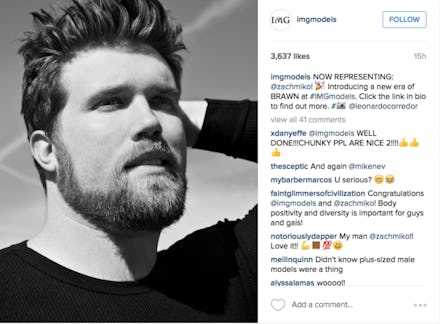Plus-Size Male Models Are Finally Getting a Descriptor of Their Own: "Brawn"

Over the past few years, plus-size models have become the talk of the town. Most recently, Ashley Graham walked for H&M and landed herself on the cover of Sports Illustrated's Swimsuit Issue. Plus-size models are making their mark by collaborating with retailers on clothing lines, including swimsuits and even activewear, and are popping up in ads.
But here's the thing: Where are the plus-size men?
Truth is, there are very few plus-size male models working at the moment, and that's precisely what IMG Models wants to change. On Tuesday, Women's Wear Daily announced the agency is launching a brand new division for plus-size guys, called "Brawn."
"The body-positive messaging and size diversity is something that's relevant and something that continues to be on everybody's mind," Ivan Bart, president of IMG Models, told WWD. "We have to extend the conversation for men."
The first model signed to the this new Brawn subsection is Zach Miko. Miko made waves in 2015 when he modeled for Target, as one of its first-ever bigger male models at 6-foot-6 with a 40-inch waist.
That's all well and good. Certainly as there are plus-size women who want to see themselves on runways and in advertisements, there are bigger guys who want the same. "I want every man in America to say, 'I can do that,' when they see Zach," Bart told WWD.
One thing that is peculiar? The choice of the word "brawn."
There's been a bit of a words war over what to call female plus-size models. The industry itself is almost obsessive about wanting to put models above a certain size into a box. If you aren't a size 12 (which is where the industry often defines "plus size" beginning, though it's not concrete), agents have been known to tell models to gain weight to get there — and things can get dangerous.
Should it be "plus size," indicating a strict numerical cutoff point? Should it be "fat," to avoid euphemism altogether and own body diversity? Should it be "curvy," to refer more to shape than to size?
Recently, younger models have started rejecting the favored "plus size" and going for "curve model" instead. It's a word that Wilhelmina Models has been using for years now, with a division called Wilhelmina Curve that launched in 2005, but it's taken a while for the term "curve model" to take off. "Curve" is less about a a size, and more about shape; women who call themselves "curve models" may not technically be "plus size," but maybe a size 8 or 10, or even 6. Curve also has a positive, sexy connotation for women.
So what about men? Within the small-but-growing plus-size male modeling world, there has already been disagreement over terminology.
"It's just weird to call a man curvy, or even thick," model Kelvin Davis told Mic in a previous interview. "It's just really awkward when you can't really think of a word. The term needs some work because I think some people are turned off by the 'plus size' word."
The aversion to "plus size" may be especially strong for men, who haven't had the experience of shopping in a plus-size section.
Davis said he favored the term "husky" or even "heavy-set," terms that refer to weight. But "brawn" is actually quite different, in that it describes strength. According to Bart, that was precisely the point.
"Brawn has a body-positive message," he told WWD. "Brawn is physical strength."
Davis, a model who probably fits the brawn criteria, is already a fan of the word's connotation. "I'm a fan of the word 'brawny' [because] it sounds masculine and fits the description of that type of model in the industry," he told Mic on Wednesday.
But it does expose a gendered double standard in our body ideals. For women, the most positive version of "big" or "fat" is "curvy," which suggests feminine sex appeal. In fact, as we see female plus-size models on the rise, sexiness has remained a most-important trait, with curvier women held to a high sex-appeal standard.
For men, on the other hand, choosing an alternative to "big" has led to the hypermasculine "brawny," playing up the stereotypical male physical ideal. "Brawn" is a positive word that brings to mind images of hunky lumberjacks and, quite literally, the Brawny Man. For men, hypermasculinity is sexy, and strength is sexy. For women, it's something else.
Both are nicer-sounding than "plus," which implies abnormality. Both are also more flattering, rather than saying "big" or "fat." But the rising terms also expose deeply entrenched differences in the beauty standards to which we hold men and women.